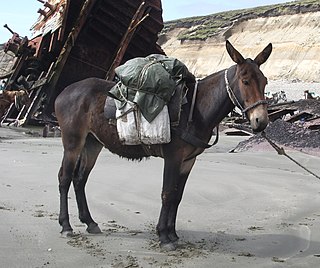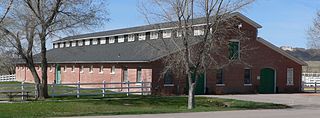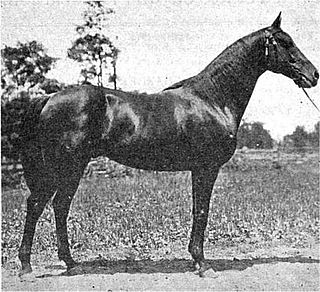
A mule is the offspring of a male donkey (jack) and a female horse (mare). Horses and donkeys are different species, with different numbers of chromosomes. Of the two first generation hybrids between these two species, a mule is easier to obtain than a hinny, which is the offspring of a female donkey (jenny) and a male horse (stallion).

The Morgan horse is one of the earliest horse breeds developed in the United States. Tracing back to the foundation sire Figure, later named Justin Morgan after his best-known owner, Morgans served many roles in 19th-century American history, being used as coach horses and for harness racing, as general riding animals, and as cavalry horses during the American Civil War on both sides of the conflict. Morgans have influenced other major American breeds, including but not limited to the American Quarter Horse, Tennessee Walking Horse and the Standardbred. During the 19th and 20th centuries, they were exported to other countries, including England, where a Morgan stallion influenced the breeding of the Hackney horse. In 1907, the US Department of Agriculture established the US Morgan Horse Farm near Middlebury, Vermont for the purpose of perpetuating and improving the Morgan breed; the farm was later transferred to the University of Vermont.The first breed registry was established in 1909, and since then many organizations in the US, Europe and Oceania have developed. There were estimated to be over 175,000 Morgan horses worldwide in 2005.

A Hanoverian is a warmblood horse breed originating in Germany, which is often seen in the Olympic Games and other competitive English riding styles, and has won gold medals in all three equestrian Olympic competitions. It is one of the oldest, most numerous, and most successful of the warmbloods. Originally a carriage horse, infusions of Thoroughbred blood lightened it to make it more agile and useful for competition. The Hanoverian is known for a good temperament, athleticism, beauty, and grace.

Harry Payne Whitney was an American businessman, thoroughbred horse breeder, and member of the prominent Whitney family.

Spearmint (1903–1924) was a British Thoroughbred racehorse and a sire. In a brief racing career which lasted from 1905 until June 1906, he ran five times and won three races. After showing moderate form in 1905, he won The Derby on his seasonal debut at age three and then became the first British horse for twenty years to win France's most important race, the Grand Prix de Paris. He became a successful breeding stallion, siring major winners in Europe and the United States. His daughters produced the winners of eight classic races. Spearmint was placed on the winning sires and brood-mare sires lists on several occasions.

Leamington (1853–1878) was a Thoroughbred racehorse, and an influential sire in the United States during the second half of the nineteenth century. He was not only a fast horse, but also showed great staying ability.

The American Cream Draft is a rare draft horse breed, the only such breed developed in the United States that is still in existence. It is recognized by its cream color, known as "gold champagne", produced by the action of the champagne gene upon a chestnut base color, and by its amber eyes, also characteristic of the gene; the only other color found in the breed is chestnut. Like several other breeds of draft horses, the American Cream is at risk for the autosomal recessive genetic disease junctional epidermolysis bullosa.

Indraff (1938–1963) was a gray Arabian stallion, foaled on May 9, 1938 and bred by Roger Selby of Ohio. His sire was Raffles and his dam was Indaia. Both his sire and dam were bred by the Crabbet Arabian Stud in England and imported to the United States by Selby.

Witez II was a bay Arabian stallion foaled at the Janów Podlaski stud in Poland. He spent his early years at Janów at a time when Poland was under occupation by Nazi Germany before ultimately arriving in the United States in 1945, where he lived for the remainder of his life until his death. His name came from an archaic Polish word meaning "chieftain, knight, prince and hero."
The Tersk Stud was officially established on February 11, 1921, on the orders of Marshal Semyon Budyonny. The breeding farm was used to restore the Russian horse population, which suffered heavy losses during the Russian Revolution.

Star Shoot was a Thoroughbred racehorse that was bred in Ireland, raced in the United Kingdom and was eventually imported to the United States to become a five-time leading sire in the early 1900s. He was a white stockinged, chestnut colt sired by the great British 1893 Triple Crown winner, Isinglass, out of the Hermit bred mare Astrology. He is best remembered for siring the American Classic winning sons Sir Barton and Grey Lag and the 1917 American Oaks winning filly Wistful I.

A part of the Quartermaster Corps, the U.S. Army Remount Service provided horses as remounts to U.S. Army units. Evolving from both the Remount Service of the Quartermaster Corps and a general horse-breeding program under the control of the Department of Agriculture, the Remount Service began systematically breeding horses for the United States Cavalry in 1918. It remained in operation until 1948, when all animal-breeding programs returned to Department of Agriculture control.

Delhi (1901–1925) was an American Thoroughbred racehorse that won the 1904 Belmont Stakes. He was the top money-winner of 1904 and was consequently named the co-historical American Champion Three-Year-Old Male Horse with Ort Wells. The following year, he was also the historical American Champion Older Male Horse, co-champion once again with Ort Wells. While Delhi did have limited success in the stud, he is not considered to be an influential sire.

Luke McLuke was a bay Thoroughbred stallion born in the United States; he won the 1914 Belmont Stakes, the Carlton Stakes, Kentucky Handicap, and Grainger Memorial Handicap among his four wins from six starts. After his racing career was over, he became a breeding stallion, where he sired 11 stakes winners. Two of his daughters were named as year-end Champions in the United States.

Eleanor was a British Thoroughbred racehorse bred by Charles Bunbury and was the first female horse to win The Derby. Eleanor also won the 1801 Epsom Oaks among many other races before retiring from racing at age eight to become a broodmare for Bunbury. She produced the stallion Muley, which in turn sired the mare Marpessa and the influential stallion Leviathan which was exported to the United States in the early nineteenth century. Through the produce of her daughter Active, Eleanor is present in the pedigrees of 19th-century American Standardbred racehorses.

Whalebone was a British Thoroughbred racehorse that won the 1810 Epsom Derby and was a successful sire of racehorses and broodmares in the 1820s. Whalebone and his full-brother Whisker were produced by the prolific and important broodmare Penelope, and they contributed to the perpetuation of the genetic line (tail-male) of their sire Waxy and grandsire Eclipse into the 20th century. Whalebone raced until he was six years old and was retired to stud at Petworth in 1815. Whalebone sired the Derby winners Lap-dog, Spaniel and may have been the sire of Moses. Other notable sons are Sir Hercules and Camel, the sire of Touchstone. Whalebone died in 1831 at the age of 24 of hemorrhage after covering a mare.

Naborr, originally named Nabor, was a gray Arabian stallion foaled in Russia at the Tersk Stud. He was sired by Negatiw, a Russian-bred stallion with Crabbet ancestry, out of the Polish-bred mare Lagodna. After establishing himself on the race track and show ring in the former USSR, Naborr was exported to Poland, where he lived for seven years, and from there was purchased for import to the United States by a wealthy Arabian horse breeder from Arizona, Anne McCormick. Upon her death, Naborr was sold in 1969 to Tom Chauncey and Wayne Newton for $150,000, which was at the time the highest price ever paid for an Arabian horse at auction. He went on to become a leading sire of champion Arabian horses in the United States and Canada.
Troutbeck was a British Thoroughbred racehorse and sire. He was beaten in three starts as a juvenile in 1905 but improved to become an exceptional racehorse in the following year. He won his first three races in 1906 before sustaining his only defeat of the season when finishing third in the Epsom Derby. He won his next five races including the Jersey Stakes and the Sussex Stakes before ending the year with a win in the St Leger. He remained in training at four but failed to win any major races although he did finish second in the Coronation Cup. After his retirement from racing he stood as a breeding stallion in Britain and the United States but was not a success at stud.
Wildfowler was an Irish-bred, British-trained Thoroughbred racehorse and sire. He showed very good form as a two-year-old in 1897 when he won three of his five races and finished third in the Middle Park Plate. In the following year he ran fourth in the 2000 Guineas and was fancied for the Epsom Derby before being scratched from the race. He returned in September to win the St Leger, upsetting the Derby winner Jeddah but did not race again. He stood as a breeding stallion in Ireland and France but was not a great success although he did sire a top-class performer in Llangibby and an influential broodmare in Silver Fowl.

Negatiw, sometimes spelled Negativ, was a gray Russian-born Arabian stallion with Crabbet ancestry. He was sired by Naseem, a Skowronek son bred in England, out of the Polish-bred mare, Taraszcza. Negatiw was credited to be the stallion that returned the Ibrahim sire to Poland. He is also regarded as the most internationally influential grandson of the immortal Skowronek.





















